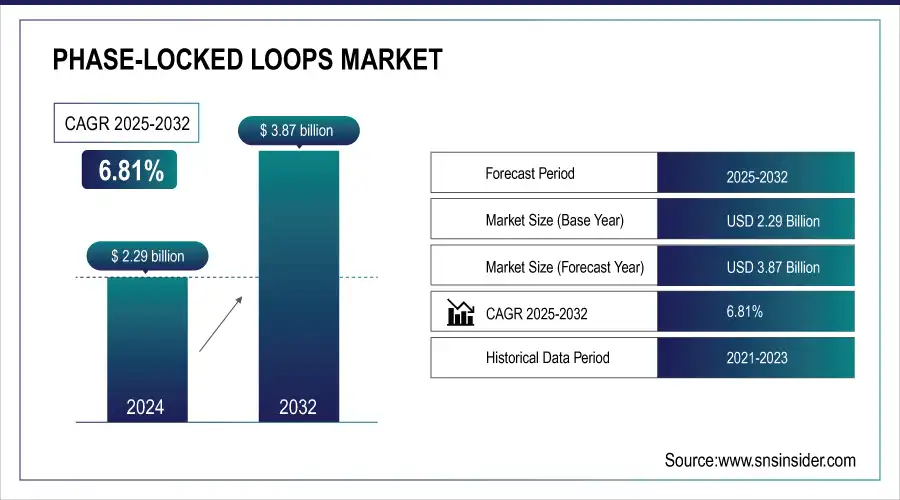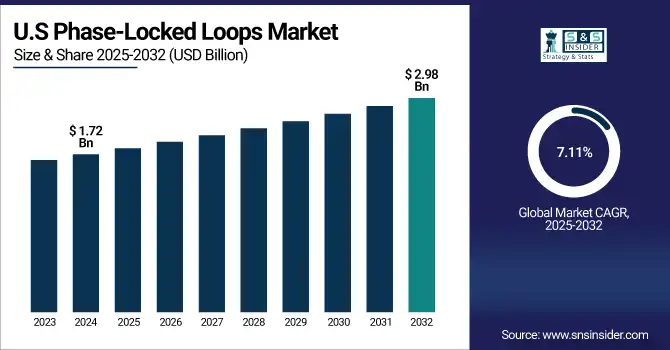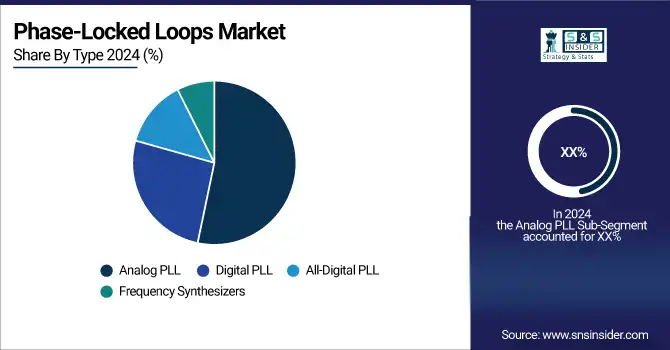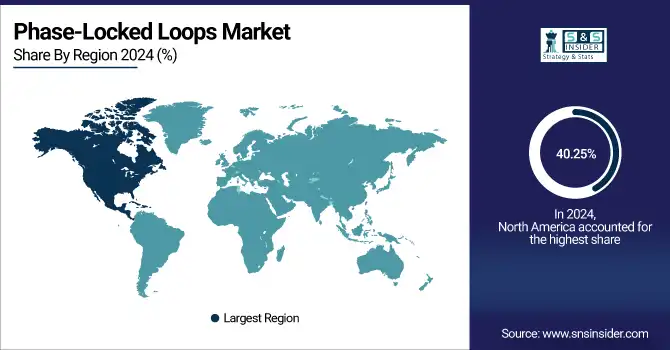Phase-Locked Loops Market Size Analysis:
The Phase-Locked Loops (PLL) Market Size was valued at USD 2.29 billion in 2024 and is expected to reach USD 3.87 billion by 2032 and grow at a CAGR of 6.81% over the forecast period 2025-2032.

To Get more information On Phase-Locked Loops Market - Request Free Sample Report
Growth is fueled by increasing demand for high-speed communication, digital devices, and automotive electronics. Integration in 5G infrastructure and data-intensive applications further boosts demand. Advancements in VCOs and CMOS-based PLL architectures are also enhancing performance, driving broader adoption across multiple industries including telecommunications, consumer electronics, and defense.
According to research, CMOS-based PLLs accounted for more than 52% of the technology segment in 2024 due to low power and scalability (Allied Market Research).
The U.S. Phase-Locked Loops Market size was USD 1.72 billion in 2024 and is expected to reach USD 2.98 billion by 2032, growing at a CAGR of 7.11 % over the forecast period of 2025–2032.

The country's dominance is driven by advanced telecommunications infrastructure, strong aerospace and defense investments, and rapid digital transformation across automotive and healthcare. Increased R&D in mixed-signal and RF-CMOS technologies and rising demand for secure, high-performance communication modules also fuel growth. Additionally, strong government funding and private sector innovation contribute to the steady expansion of the U.S. market.
In 2024, over 14 million connected vehicles were registered in the U.S., integrating advanced PLL-based communication modules (NHTSA).
PLLs Market Dynamics:
Key Drivers:
-
Ramp-up in 5G and wireless communication deployments is accelerating Phase-Locked Loops integration in RF systems.
The global rollout of 5G networks requires highly precise frequency generation and low phase noise performance. Phase-Locked Loops are essential components in RF front-ends, enabling stable clock generation and carrier synchronization. As telecom operators expand infrastructure and device manufacturers upgrade to 5G-enabled hardware, Phase-Locked Loops demand is rising sharply. The trend toward millimeter-wave communication and beamforming further increases Phase-Locked Loops complexity and volume. This rapid deployment of next-generation wireless infrastructure significantly contributes to growth in Phase-Locked Loops market demand.
According to research, over 70% of new 5G networks in the U.S., Japan, and South Korea now operate in mmWave bands for enhanced data speeds.
Restraints:
-
Increasing design complexity and verification costs limit adoption among low-cost device manufacturers.
The push for advanced features such as ultra-low jitter, multi-loop designs, and high-frequency operation increases PLL design complexity. Verification and testing require sophisticated tools and time-consuming calibration, adding to development costs. Low-margin consumer device makers may avoid integrating advanced PLL solutions due to higher BOM costs and longer time-to-market. This restraint limits market penetration among small-scale OEMs and emerging markets that prioritize cost over advanced performance, slowing segment growth.
Opportunities:
-
Rise of autonomous vehicles and ADAS systems is creating new demand for high-precision PLLs in automotive applications.
Advanced driver-assistance systems (ADAS) and autonomous driving platforms require precise timing for sensor synchronization, LiDAR, radar, and communication modules. High-performance PLLs ensure stable clock signals and minimize phase noise, critical for reliable real-time operation. As automotive OEMs increase ADAS features and invest in autonomous prototypes, demand for automotive-grade PLLs is rising. This trend opens opportunities for PLL suppliers to develop ruggedized, automotive-qualified designs that meet stringent reliability and performance standards.
According to research, more than 1,400 autonomous vehicle pilot projects are active globally as of 2024, led by firms in the U.S., China, and Europe.
Challenges:
-
Rapid evolution of competing clocking technologies may disrupt traditional PLL usage in emerging applications.
Emerging hybrid clocking solutions such as injection-locked oscillators, delay-locked loops, and MEMS-based timing devices pose alternatives to traditional PLL circuits. These technologies offer better phase noise performance, lower power consumption, or reduced footprint. Continuous innovation in timing architectures may erode PLL’s dominance in certain applications. PLL manufacturers must adapt by integrating hybrid technologies or developing advanced architectures to stay relevant, creating challenges in strategic planning and R&D allocation.
Phase-Locked Loops Market Segmentation Analysis:
BY Type
Analog PLLs held the largest market share in 2024 due to their simplicity, reliability, and cost-efficiency across RF systems and industrial controls. These PLLs remain highly favored in legacy infrastructure and low-noise communication systems. Texas Instruments continues to offer a broad range of analog PLLs tailored for precision and stability, which further strengthens their dominance in industries where analog designs are still in high demand.
All-Digital PLLs are projected to grow at the fastest pace through 2032, thanks to their flexibility, digital compatibility, and easy integration into modern semiconductor processes. These are increasingly adopted in SoCs, high-speed data systems, and advanced computing platforms. MediaTek has been actively innovating in this space by incorporating digital PLLs in its chipsets to support high-frequency synchronization and adaptive digital signal processing for next-gen devices.

BY Component
In 2024, VCOs emerged as the dominant component in the PLL market, holding the largest share due to their essential role in frequency tuning and signal synthesis. They are integral to wireless networks, satellite systems, and communication modules. Analog Devices continues to lead this space with a robust portfolio of VCOs designed for high-frequency performance, low phase noise, and enhanced frequency stability in various RF applications.
VCOs are also the fastest-growing component in the market, projected to expand significantly due to increasing demand across IoT, radar systems, and 5G infrastructure. Their evolving role in precise signal modulation is driving further innovations. Qorvo is actively enhancing its RF component portfolio, including advanced VCO modules, to meet the performance needs of next-generation wireless and defense communication technologies.
BY Application
Telecommunications dominated the PLL application segment in 2024, driven by constant demand for synchronization in cellular networks, base stations, and satellite communication systems. Accurate clocking is vital for network efficiency and signal clarity. Qualcomm has played a pivotal role here by integrating high-performance PLLs into its 5G chipsets and communication modules to support faster data rates and ultra-low latency in modern telecom infrastructure.
The automotive segment is witnessing the fastest growth due to increasing integration of PLLs in radar, LIDAR, ADAS, and infotainment systems. The push toward autonomous and electric vehicles necessitates accurate signal timing and frequency control. NXP Semiconductors is advancing automotive PLL technology, focusing on safety-certified and low-jitter PLLs that enable real-time response and improved signal accuracy for future mobility solutions.
BY Teachnology
CMOS technology led the PLL market in 2024, thanks to its low power consumption, cost-effectiveness, and integration efficiency in consumer electronics. It's widely used in mobile devices, wearables, and embedded systems. STMicroelectronics has been instrumental in driving CMOS-based PLL adoption with scalable, energy-efficient solutions, making them suitable for a range of compact, battery-powered applications across the IoT and consumer device landscape.
CMOS continues to grow rapidly, backed by its compatibility with submicron processes and ability to support high-frequency signal generation in compact formats. Its scalability and affordability make it the preferred technology in smartphones and wireless communications. Infineon Technologies is expanding its CMOS-based PLL lineup, developing high-speed, ultra-low power solutions that cater to demand from portable medical devices, smart appliances, and advanced connectivity platforms.
BY End-User Industry
In 2024, telecommunications was the leading end-user industry for PLLs, owing to rising demand for signal synchronization in broadband, wireless, and satellite systems. PLLs are indispensable for ensuring reliable network operations. Broadcom Inc. stands out in this domain, offering telecom-optimized PLLs embedded in network processors, timing ICs, and transceivers that power next-generation wireless and data communication systems.
In 2024, telecommunications was the leading end-user industry for PLLs, owing to rising demand for signal synchronization in broadband, wireless, and satellite systems. PLLs are indispensable for ensuring reliable network operations. Broadcom Inc. stands out in this domain, offering telecom-optimized PLLs embedded in network processors, timing ICs, and transceivers that power next-generation wireless and data communication systems.
Phase-Locked Loops (PLL) Market Regional Outlook:
North America dominated the Phase-Locked Loops Market with the highest revenue share of about 40.25% in 2024 due to its well-established telecommunications infrastructure, extensive adoption of advanced defense technologies, and strong presence of semiconductor giants. The region benefits from robust research and development initiatives, consistent demand for high-frequency components, and early adoption of emerging technologies in aerospace, automotive, and consumer electronics. Companies like Texas Instruments and Broadcom have contributed significantly to market leadership by delivering high-performance PLL solutions tailored to critical industrial and communication applications.

Get Customized Report as per Your Business Requirement - Enquiry Now
-
The U.S. dominates the North American Phase-Locked Loops market due to its advanced semiconductor industry, strong presence of key market players, and high demand from aerospace, defense, and 5G infrastructure sectors, driving continuous innovation and large-scale PLL adoption.
Asia Pacific segment is expected to grow at the fastest CAGR of about 7.85% from 2024 to 2032, fueled by rapid industrialization, expansion of 5G networks, and booming consumer electronics production across China, India, South Korea, and Japan. Rising investment in semiconductor manufacturing, along with favorable government initiatives supporting digital infrastructure, has accelerated PLL demand. Leading companies such as MediaTek and Samsung are expanding regional manufacturing and design capabilities, further driving innovation and adoption of PLLs in automotive, telecommunications, and IoT-based systems.
-
China dominates the Asia Pacific Phase-Locked Loops market due to its massive electronics manufacturing base, rapid 5G deployment, and strong government support for semiconductor development, enabling widespread PLL integration across consumer electronics, automotive systems, and telecommunications infrastructure.
Europe plays a significant role in the Phase-Locked Loops market, driven by growing demand across automotive electronics, industrial automation, and aerospace sectors. Countries like Germany, France, and the UK are investing in advanced communication systems and semiconductor technologies. The region benefits from established R&D capabilities, robust regulatory frameworks, and rising adoption of PLLs in electric vehicles and defense applications.
-
Germany is the dominating country in the European Phase-Locked Loops market. Its leadership is driven by a strong automotive electronics industry, advanced industrial automation, and significant investment in semiconductor R&D. Germany’s well-established infrastructure, engineering expertise, and presence of major OEMs contribute to higher PLL adoption across various high-tech applications.
The Middle East & Africa Phase-Locked Loops market is led by the UAE, driven by rapid telecom growth and smart city projects. In Latin America, Brazil dominates due to expanding electronics manufacturing and telecom modernization. Both countries benefit from government support and rising demand for advanced frequency control technologies.
Phase-Locked Loops (PLLs) Companies are:
Major Key Players in Phase-Locked Loops Market are Texas Instruments, Analog Devices, Broadcom, STMicroelectronics, NXP Semiconductors, Infineon Technologies, Qualcomm, ON Semiconductor (onsemi), Renesas Electronics, Skyworks Solutions and others.
Recent Developments:
-
In January 2024, The JetPLL series (7200, 7210, 7220) introduced by THAT Corporation are digital PLLs designed for high-precision audio clocking, which directly contributes to the phase-locked loop technology landscape, especially within the professional audio and signal processing segment of the market.
-
In June 2024, Texas Instruments released the LMX2492, a 14 GHz fractional-N PLL offering industry-leading phase noise performance. Supported by a comprehensive evaluation module (LMX2492EVM), TI enables simplified system design with advanced loop filter simulation and clock tree optimization tools.
| Report Attributes | Details |
|---|---|
| Market Size in 2024 | USD 2.29 Billion |
| Market Size by 2032 | USD 3.87 Billion |
| CAGR | CAGR of 6.81% From 2025 to 2032 |
| Base Year | 2024 |
| Forecast Period | 2025-2032 |
| Historical Data | 2021-2023 |
| Report Scope & Coverage | Market Size, Segments Analysis, Competitive Landscape, Regional Analysis, DROC & SWOT Analysis, Forecast Outlook |
| Key Segments | • By Type (Analog PLL, Digital PLL, All-Digital PLL, Frequency Synthesizers) • By Component (Phase Detector, Low Pass Filter, Voltage-Controlled Oscillator (VCO), Frequency Divider, Loop Filter) • By Application (Telecommunications, Consumer Electronics, Automotive, Data Communication, Signal Processing, Industrial Control Systems) • By Technology (Mixed Signal Technology, CMOS Technology, Bipolar Technology, BiCMOS Technology) • By End-User Industry (Consumer Electronics, Telecommunications, Aerospace & Defense, Information Technology, Automotive Electronics, Healthcare Devices) |
| Regional Analysis/Coverage | North America (US, Canada, Mexico), Europe (Germany, France, UK, Italy, Spain, Poland, Turkey, Rest of Europe), Asia Pacific (China, India, Japan, South Korea, Singapore, Australia,Taiwan, Rest of Asia Pacific), Middle East & Africa (UAE, Saudi Arabia, Qatar, South Africa, Rest of Middle East & Africa), Latin America (Brazil, Argentina, Rest of Latin America) |
| Company Profiles | Texas Instruments, Analog Devices, Broadcom, STMicroelectronics, NXP Semiconductors, Infineon Technologies, Qualcomm, ON Semiconductor (onsemi), Renesas Electronics, Skyworks Solutions. |

